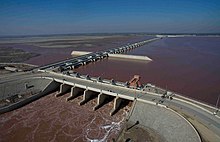Khanki Headworks
Is a headworks situated
on the River Chenab in Gujranwala District of the Punjab province
of Pakistan.
It was constructed in 1889 and was one of the oldest headworks in Pakistan.
Khanki headworks is also used to divert water to the Lower Chenab Canal, which originates from Khanki Headworks. Khanki controls water distribution over 3 million acres (12,000 km²) of agricultural lands by one main distributary, the Lower Chenab Canal, and 59 minor distributaries.
The old "Head Khanki Barrage
 |
| Old Head Khanki |
built-in 1892 on the Chenab River by the British to convert 3 million acres of barren land into cotton and wheat fields. The barrage was built 16-km downstream of Alexandra Railway Bridge with stone and rubble masonry with a maximum capacity of 800,000 cusecs. The Lower Chenab Canal originates from the Barrage carrying about 11,600 cusecs of water. The weir originally was a shuttered type weir comprising 8 spans of 500 ft each and was the first one in Punjab which was built upon alluvial soil. The weir got repeatedly damaged in portions and had to be remodeled extensively during 1919- 1920 and 1933- 1935. Over time the structure showed some serious engineering defects so after detailed analysis and research it was decided to build the whole barrage new and demolish the previous one. The construction of the new Khanki Barrage was completed in August 2017 but the barrage was formally handed over to the Punjab Irrigation Department in June 2019.
The new Khanki barrage
 |
| New Khanki Barrage |
Construction projects cost Rs. 21.3 billion with 87 percent of the funding provided by the Asian Development Bank. New Khanki Barrage will divert 11,653 cusecs of sustainable irrigation supplies to the downstream lower Chenab Canal. The irrigation distribution system has already been remodeled for additional flows.
The barrage will ensure sustainable irrigation of 3.03 million acres of fertile land in eight districts of central Punjab - Gujranwala, Hafizabad, Sheikhupura, Nankana Sahid, Faisalabad, Jhang, Chiniot, and Toba Tek Singh. The project will benefit about 568,000 farming families and reduce flooding risks from once in 50 years to once in 100 years.






Comments
Post a Comment
if you have doubt, please let me know.